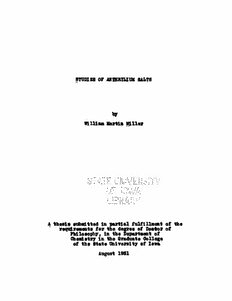Table Of ContentOf MIHRTIiIlJM SALTS
BWMM
I f
minoB m u m m u m
A theaio *t*a itte d in p artia l fa l£ llla « ttt at tls®
' Vaftaraaraats fay tie degreo at Beoto* of
m iaaophy» la tho Bapartaent of
fiaatafa? in ttie GsrafaaAa ® olla*i
of tia Stota tfcivaaaitf of Xatra
iognst 1981
ProQuest Number: 10666204
All rights reserved
INFORMATION TO ALL USERS
The quality of this reproduction is dependent upon the quality of the copy submitted.
In the unlikely event that the author did not send a complete manuscript
and there are missing pages, these will be noted. Also, if material had to be removed,
a note will indicate the deletion.
uest
ProQuest 10666204
Published by ProQuest LLC (2017). Copyright of the Dissertation is held by the Author.
All rights reserved.
This work is protected against unauthorized copying under Title 17, United States Code
Microform Edition © ProQuest LLC.
ProQuest LLC.
789 East Eisenhower Parkway
P.O. Box 1346
Ann Arbor, Ml 48106 - 1346
m s s m n m m z .
The author wishes to express bis sincere appreci
ation to Dr. Ralph 1>. Sbriner, who conceived this research
project and for his encouragement, guidance and many help
ful suggestions throughout its course*
fABLE OF OOITESTS
t, rHTROWJOflON 1
II* SISTORIOAI. 4
A. Synthesis of 9-Pb«iy3»10,10-
dlst&stltuteA*®, lO-dlhyd*08nth;eols 5
B. Convezslonof Dihydyoanthxols
to Dihydroanthracsnee 8
8* CMboniuM Salts of 9»Phenyl«10,10«-
dlsutoetitutsd-9, lO-dibydiosnthafaeenee 9
D. The aajebonitua structure 10
E. Hitration of Aryloazbonium Salts 19
III. THEOSOTCAA ARB DI80U88I0H Of RESUMIS 16
A* Synthesis of 9-Pheny 1-1G*-10~
distfbstituted-B,10-dihydroanthrols 16
8. Conversion of Bihydroan thro Is
to Bihydzoanthx&ssbas 30
0. Preparation and Analysis of
AnthrylluB Perchlorates 31
0. Httzatian of &-Ph©ayl»10,10-
dlsttostituted-9, ia-.dlhydroanth*ylium
salts 33
B, Absorption Spectra of Anttoyllm
Salts 37
I Vi sxpxammt. 39
Anthrone 39
10.10-Bicbloroanthrone 89
10.10-Blphenylanthxone 40
9,10,IQ-Trl phenyl-9,10-dihydroanthrol 40
10.10-Dib en sylantbrone 41
®<*Fhenyl~XO# lO-dibenayl^Q, XO-dihydro-
anthroX 42
%Q $ XO**BIe thyXan thr one 42
9*fh©nyX<*X0;» l0-diethyl«*9* XO-dlhydro-
anthroX 43
Bthoxy Derivative of ®->PhenyI**XO, XO*
diethyl-9* XO**dihydroanthrol 44
®#I0, X0-TriphenyX*9, XO-^dihydroanthracen© 44
9*PhenyI«*I0* lO-dibtoyX"® f 10~dihydroan«*
thracen© 45
9*FhenyI**XQ , X0-diethyX^9, XO^dihydroan-
thracene 46
9*10 * X0~TriphenyX~9* IQ-dihydroanthrylium
perchlorate 46
®**Fhenyl*X0# XO~dlben&yX~9* XO«dihydroan~
thryXium perehXoraie 47
Methoxy Derivative of 9~?henyI<*XQs»X0*’
dXben&yI«*9, XO-dihydroanthroX 48
9**PhenyI<*X0f I0«*diefchyX~9, XO^dihydroan-
thrylium perchlorate 49
Hitration of 95XO, IO*TpiphenyI~$*I<>*di*»
hydroanthrylium nitrate 49
Hitration of S-Phenyl-XOjlO-dibenzyl-S,
XO-dihydro&nthryXium nitrate 50
Dichrcmat© Oxidation of Products of Hi
tration of 9«Ph@nyX**I0>X0~dibenKyI-9,X0~
dihydro&nthrylium nitrate 51
XO, XO-Dl (p«*nitrohenlsyX) enthrone 53
Action of PhenyXmagnesium bromide on
10,10*Di(p-nitrobenzyX)enthrone 53
Hitration of 9^Hxenyl^X0#lO-»diethyl-9,lO^
dihydroanthrylium Salts 54
Absorption spectra measurements 55
rnmrn
00
?*
VI* $%
VII# B10GHAPHI 63
1
IBTRODOCTIOH
Carbonium ions are often postulated as lntermsdl*
atea in organic reactions. These Ionia compounds are seldom
isolated because of their transitory existence* However$
when the groups attached to the eleetron deficient carbon
are aromatic* then definite crystalline salt-like compounds
oan be isolated* la these eeapeunds the aryl groups offer
opportunity for stabilization by resonance* and this idea
has proven useful in explaining why such carbonium salts can
be isolated* Such carbonium ion compounds exist combined
with various ions derived from strong mineral aeids as high*
ly colored* polar* crystalline salts*
Trlphsnylearbenlum (I)**2* bensopyrylluu (II)S»4*
isobenzopyrylium (111)2 and xanthylium (IV)2 salts have been
prepared* They are probably resonance hybrids* but one eon*
tributing bond structure for each is shorn in the following
formulas*
A
X
2
/
A
\
s
/
M
Oh# lint of experimental evidence supporting such
(
a attributing bond structure is the fast that these cation
ic salts orient p i entering nitre group to the meta position
in the phenyl group attached to the carbonium ©arbon atm*
Bem&pyxf Hum# is oben&opyry1 ium md xm th yllm
structures contain a heterocyclic oxygen atom which Increases
the number of resonance structures possible in these com*
pounds# Therefore* It was of interest to study compounds
which contained no heterocyclic oxygen atom* The objects of
the present research project were to study the preparation
and properties of anthryllum salts#
In the anthrylium salts investigated in this pro
ject a disubstituted carbon atom replaced the heterocyclic
oxygen atom of the otherwise structurally comparable x&nth-
yllum salts • The saturated carbon atm was Intended to limit
the resonance possibilities of the system# The anthrylium
$
salts studied wars all of the 9**phenyl~X0* IQ-*disubstitufced~9*
lO^&ihydroanthraeene type as shown by the general structural
formula (w),
s
2T
II
HISTORICAL
The anthrylium salt* of tbs 9-phenyl»l0.10-dlsub-
stltuted-9» iO*dlhydroanthreeene (VI) type which were consid
ered moot suitable for study were those which had phenyl,
hensyl and ethyl groups attached to the number 10 carbon
atom.
By analogy to the synthesis of other aryl carbonium
salts anthryliise salts should be readily formed from the cor
responding dihydroanthrols by reaction with a strong acid
such as perchloric acid. These oarbinols hare been obtained
by the action of Srignard reagents on the enthrones* The
general reactions are as followst
i)HzO
-
Hence a literature survey was made to find suit**
able methods for preparing the substituted enthrones and

